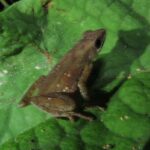Secrets of the Forest Floor: Getting to Know the Rare Ischnocnema vizottoi Frog#
Introduction#
In the heart of the Atlantic Forest, beneath dense, sun-dappled canopies filled with the hum of insects and chatter of birds, lies a tiny, often unnoticed amphibian whose silent presence speaks volumes about the health of its delicate environment. This elusive creature is Ischnocnema vizottoi, a remarkable species of frog rarely discovered without careful searching and patience. Yet, despite its inconspicuous appearance and quiet demeanor, I. vizottoi plays a profound role in the ecosystems it inhabits, serving as an intricate connection between the forest floor and the greater web of life above.
Discovered relatively recently, Ischnocnema vizottoi is named in honor of renowned biologist Luiz Dino Vizotto, who significantly advanced the understanding of Brazilian amphibian biodiversity. This fascinating frog’s story sheds light on the understated beauty and ecological importance of amphibians worldwide, quietly reminding us of the secrets still undiscovered in remote habitats.
Taxonomy and Classification#
Ischnocnema vizottoi belongs to the family Brachycephalidae, known commonly as “robber frogs” or “leaf litter frogs.” This diverse frog family includes many small-sized species mainly distributed throughout Central and South America. The genus Ischnocnema is distinguished especially by its direct developing offspring, bypassing the aquatic tadpole stage entirely—an evolutionary adaptation intriguingly suited to their leaf-litter dwelling existence.
The complete taxonomic hierarchy of the species is:
- Kingdom: Animalia
- Phylum: Chordata
- Class: Amphibia
- Order: Anura
- Family: Brachycephalidae
- Genus: Ischnocnema
- Species: Ischnocnema vizottoi
Although closely related to other species within the genus, I. vizottoi exhibits unique morphological distinctions, particularly in its vocalizations and subtle anatomy, warranting its recognition as a distinct species.
Natural Habitat#
Exclusive to the lush yet threatened Atlantic Forest of southeastern Brazil, Ischnocnema vizottoi makes its home beneath a thick carpet of damp leaves and rotting wood. The region, rich in biodiversity and featuring high humidity and temperate conditions year-round, provides an ideal habitat. Areas inhabited by this frog are often located at moderate elevations (typically 500 to 900 meters above sea level), where temperatures remain stable and moisture is most abundant.
The forest’s vibrant understory is alive with insects, spiders, and other invertebrates—an abundant food source for the tiny frogs. Perfectly camouflaged within their leaf-litter domains, these frogs rarely venture far from refuge, relying instead on their remarkable adaptation to blend seamlessly with their environment. This camouflage affords protection from predators and ensures their survival amid rampant ecological change, highlighting the critical importance of preserving these unique forest ecosystems.
Physical Characteristics#
The first glance at Ischnocnema vizottoi might mistakenly identify it as merely another fallen leaf or a small piece of bark. Its petite frame measures just about 20-25 millimeters from snout to vent, making it a master of subtle concealment. Colors vary among individuals: muted shades of brown, olive-green, or gray adorned with intricate patterns mimicking decaying foliage or forest litter. Such camouflage not only aids in predator avoidance but also enhances their stealthy hunting tactics.
The skin texture of I. vizottoi contributes to its disguise—finely granular with minute bumps, almost indistinguishable from the surrounding leaves and soil granules in the dimly lit forest floor. Large forward-facing eyes, typically golden or bronze, offer a critical evolutionary advantage, granting superior depth perception needed for accurate insect predation.
Behavior and Life Cycle#
Predominantly nocturnal, Ischnocnema vizottoi emerges after sunset to feed actively on insects and other small invertebrates. Equipped with precise hunting instincts, these frogs exhibit a sit-and-wait strategy, camouflaged and motionless, before capturing prey with extraordinary speed and accuracy.
Unlike common frogs undergoing a fully aquatic tadpole stage, Ischnocnema vizottoi employs direct development—as amazing as it is efficient. Females deposit small clutches of moist eggs hidden within protective leaf-litter nests. These eggs develop directly into miniature frogs, bypassing aquatic stages completely, a true marvel of evolutionary adaptation designed to combat unpredictable aquatic environments.
Males, primarily during rainy seasons, calling softly from secluded perches beneath leaves or moss-covered logs, perform delicate vocalizations—crispy clicking and high-pitched trills—to attract mates. This auditory fingerprint is key to identification by herpetologists surveying the dark forest.
Ecological Role#
The ecological significance of Ischnocnema vizottoi extends far beyond its diminutive stature. Acting as both predator and prey within its ecological niche, the species maintains intricate food web relationships. By regulating insect populations, they help stabilize the lower ecological tiers, which in turn sustains predation networks stretching up to birds and larger amphibians or reptiles.
Frogs like I. vizottoi also play a vital role as biological indicators or “bioindicators.” Sensitive to environmental fluctuations such as pollution, climate change, or habitat degradation, their absence or declining populations provide crucial early warning signs of ecosystem distress, informing researchers and conservationists promptly of disturbances within the habitat.
Threats and Conservation Status#
Presently, little extensive data exist explicitly outlining the populations of Ischnocnema vizottoi. However, due to their limited distribution and specialization to Atlantic Forest remnants—a global biodiversity hotspot profoundly affected by human activities—concerns are significant. Habitat fragmentation, deforestation for agriculture and urbanization, climate change-driven fluctuations, and pollution persistently threaten vital habitats needed by this delicate species.
While currently Ischnocnema vizottoi faces potential vulnerability, ongoing research and fieldwork are essential for a comprehensive assessment. Conservationists advocate urgently for the protection of intact forest habitats, ecological restoration, and the establishment of protected corridors to sustain viable populations in the wild.
Cultural and Scientific Significance#
Though keeping a discreet profile, frogs including Ischnocnema vizottoi hold considerable cultural symbolism in indigenous South American communities, often representing fertility, rain, and renewal. Scientifically, frogs of this genus continue providing valuable discoveries, especially in understanding vertebrate adaptation and developmental biology. Their unique reproductive strategies and resilience to environmental changes offer valuable biological models for studying adaptation and evolution under rapidly altering global conditions.
Conclusion#
Ischnocnema vizottoi embodies the hidden beauty and ecological complexity of the natural world—a small creature holding significant ecological, scientific, and cultural meaning beneath the dense canopy of Brazil’s endangered Atlantic forests. As we unravel its many mysteries, the call to action is unmistakable: protect the fragile habitats that harbor such astonishing biodiversity. Through increased awareness, continued research, habitat conservation, and sustainable environmental stewardship, we have the power to ensure that future generations may also marvel at the delicate wonders of Ischnocnema vizottoi and the magical subtleties of rainforest amphibian life.







